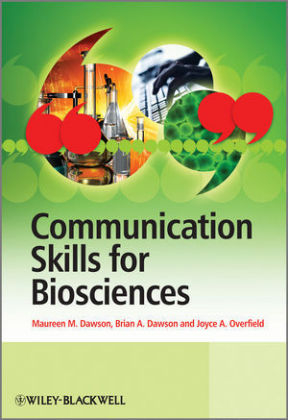
Communication Skills for Biosciences
John Wiley & Sons Inc (Verlag)
978-0-470-86393-0 (ISBN)
This text is comprehensive, user-friendly handbook that will guide students through the full range of written and spoken communication skills that are demanded by today's biosciences courses. The book also offers a valuable refresher for postgraduate students who wish to review or expand their proficiency in these areas. This book will provide the student with practical advice on how best to communicate scientific material to different audiences including their peers, their tutors and to non-scientists. Key Features:
Highly accessible, confidence-building, student-friendly guide
Provides comprehensive coverage of the complete range of presentation skills needed by students
Covers essay writing, practical reports, dissertations, projects and presenting in individual, group and poster presentation settings
Offers advice on how to avoid common errors including plagiarism using 'what not to do' boxes throughout the text
Includes practical advice on how best to communicate scientific material to different audiences e.g. undergraduates, tutors and non-scientists
Dr. Maureen Dawson, Department of Biological Sciences, Manchester Metropolitan University, UK Brian A. Dawson, Secretary to the Faculty of Science and Engineering, University of Manchester, UK Joyce Overfield, Senior Lecturer, School of Biology, Chemistry and Health Science, Manchester Metropolitan University, UK
Preface. Acknowledgements.
1 Communication Skills in Science.
About this chapter.
Why are communication skills important for scientists?
Scientific writing: a little bit of history.
Scientific language.
Peer review.
Basic rules for writing (scientific) English.
Punctuation.
More on plural words.
Commonly confused words.
Commonly misspelled words.
UK and American English.
Further reading.
2 Using Scientific Literature.
About this chapter.
What is scientific literature?
Where to start.
Peer review.
Why use scientific literature for your assignments?
Reading the literature.
Using material from the Internet.
Plagiarism.
Referencing conventions.
The Harvard style of referencing.
Quotations and how to cite and reference them.
Using software to generate your references.
Examples of citations and references.
References.
Further reading.
3 Essay Writing.
About this chapter.
The purpose of assignments.
Why write an essay?
Skills.
Preparation.
The paragraph.
The sentence.
General points of style.
Plagiarism.
Examination essays.
Further reading.
4 Writing Practical Reports.
About this chapter.
Introduction.
Some general points.
What to do before the practical session.
During the practical session.
How should it be written?
Other forms of report.
Further reading.
5 The Project Report.
About this chapter.
Introduction.
How to begin.
Writing the report.
Dissertation-based projects.
Ethical issues to consider when reporting your project work.
And finally ... .
Further reading.
6 Scientific Posters.
About this chapter.
Why use posters?
When to use a poster format.
Designing a poster.
Printing your poster.
Examples of posters.
Further reading.
7 Oral Presentations.
About this chapter.
Introduction.
Rules to follow and pitfalls to avoid.
Presentations with a group of participants.
Summary: a quick guide to oral presentations.
Further reading.
8 Preparing a Curriculum Vitae and Job Application.
About this chapter.
Introduction.
The curriculum vitae.
Covering letters.
Application forms.
How to write a good personal statement.
Interviews.
Personal development planning.
Some terms.
Further reading.
Index.
| Erscheint lt. Verlag | 26.4.2010 |
|---|---|
| Verlagsort | New York |
| Sprache | englisch |
| Maße | 168 x 244 mm |
| Gewicht | 318 g |
| Themenwelt | Naturwissenschaften ► Biologie ► Allgemeines / Lexika |
| ISBN-10 | 0-470-86393-5 / 0470863935 |
| ISBN-13 | 978-0-470-86393-0 / 9780470863930 |
| Zustand | Neuware |
| Haben Sie eine Frage zum Produkt? |
aus dem Bereich


